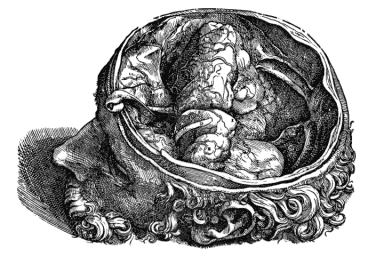By Marri Lynn (W&M Regular Contributor)
In the thousands of years of medical history preceding CAT scans, X-rays, and endeavors like the Visible Human Project, medical professionals often relied on two-dimensional drawings to inform their visualization of the inner workings of the human body. But drawings were often expensive to reproduce even with the advent of the printing press, and came with their own difficulties of representation. More often than not, medical professionals relied on the incredible power of their own imaginations to replace or augment these images.
Metaphor fit uniquely into their intellectual toolkit. Our word ‘metaphor’ comes to us through Old French, originally from the Greek words meta and phero. Meta means “between,” and phero means “to carry.” The resulting meaning is, then, “to carry [a concept] between.” Modern cognitive scientists have recognized the importance of conceptual analogy in our mental processes; some, like Douglas Hofstadter, have even gone so far as to say that “analogy is everything.”
Metaphors abound in the De Humani Corporis Fabrica, a well-known and stunningly illustrated 16th-century anatomy book by the anatomist Andreas Vesalius. I was particularly struck by his use of mechanical metaphors, and their implications for both Vesalius’ intellectual inheritance, and pre-modern anatomy’s handling of analogies. Mechanistic imagery is often considered a child of industrialization, but Vesalius shows us that in fact, the analogy of body-as-machine was alive and well centuries before. Indeed, it was a brainchild of antiquity, and a set of metaphorical imagery that Vesalius inherited and expanded upon to good effect.
Vesalius described veins, arteries, and nerves as hollow tubes, “like a pipe.” The metaphor wasn’t simply a visual comparison, but rather, a mnemonic for their functions in the body. In Greek medicine, the arteries were said to convey the ‘vital spirit,’ while the nerves conveyed ‘animal spirit.’ The Latin word spiritus which Vesalius used to describe these animating fluids derived from the Greek pneuma, or ‘breath,’ from which we get our word pneumatics. The functional meaning – air giving motion – would have been immediately clear to one of Vesalius’ educated readers. The Hellenistic world had many automata, self-animating toys and devices which made use of water or steam to produce motion. These, too, persisted in Vesalius’ world. It’s believed that a 15” high clockwork monk, currently held in the Smithsonian Institution, was designed by Juanelo Turriano for the Holy Roman Emperor Charles V – the very same man to whom Vesalius dedicated his Fabrica.
In his use of moving metaphors, we can really see Vesalius’ attempt to get his readers to think of the body dynamically while studying anatomy; something which his two-dimensional images could not do on their own. For example, trying to describe the potential for rotational movement of the femur, or thigh bone, he writes, “It is as if you took a stick between your two extended hands and rotated it by drawing them alternately forward and backward: the ninth and tenth muscles correspond to your hands, and the femur might well be likened to the stick.” In his attempt to describe the functional movement of ligaments, he writes, “Charioteers imitate this cunning device of Nature by the rings that they put on the yokes of horses so as to control, by means of a long rein passed through the ring, horses on which they are not actually sitting.”
The example of the ‘cerebral winepress’ best represents Vesalius’ conditional acceptance of his metaphorical heritage. In the 4th century BCE, the scientist Herophilos named the confluence of sinuses at the back of the skull the lenos, or winepress. In the Latin-speaking world, this became the torcular Herophili, or Herophilos’ winepress. This confluence of sinuses sent blood into the different sinus channels “like wine from a winepress,” a motion easy to visualize through that analogy. Vesalius refers to this minor anatomical detail specifically in order to address the fact that Galen applied this name to not one part of the confluence of sinuses, but two. A sentence later, Vesalius makes his unique philosophy on the utilization of these inherited metaphors fairly clear. He states frankly that he did not care what specific part the name was applied to, “provided that you do not pervert the system of the cerebral sinuses and vessels.” Vesalius’ text exhibits an awareness and care about the semantic debates within medicine, without getting overwhelmed by them. Observation came first, metaphor second, and then only in a useful capacity.
Vesalius, like his anatomist forefathers, saw the body as a describable, mentally accessible, and comprehensible entity – an attitude which aided in the demystification of the inner body. Vesalius conceived of the body as a whole formed by moving parts, and implied that man’s engines and inventions were in imitation of Nature, and not the other way around. In other words, Vesalius, like his medical forefathers, saw innate principles of physical design in the operations of the body, which mankind had unknowingly imitated in his technological inventions. Through comparing the two, he populated the idea of the body with functional machines and architectural forms, rendering a mysterious world suddenly as discoverable as a new city.
Marri Lynn holds an MA in the History of Medicine at McGill University, Montreal (2011). She is currently a freelance a writer and copy editor. You can find out more at her About.me page.

